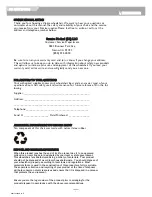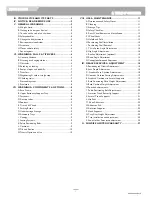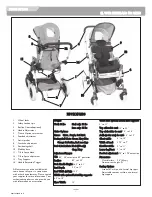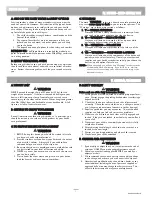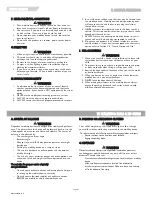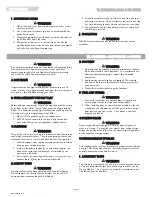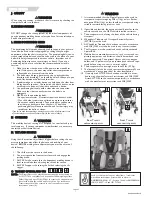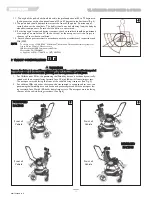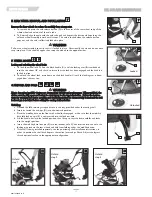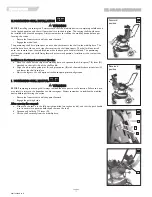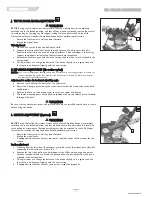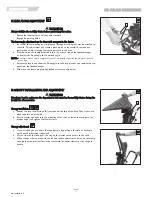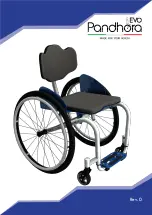
7
Z I PP I E XP R E SS
D. REACHING OR LEANING
WARNING
If your child reaches or leans it will affect the center of balance of the mobil-
ity device. This may cause a fall or tip over.
•
NEVER allow your child to reach or lean if they must rise up off
their seat for the action.
•
If your child must reach, move the mobility device as close as you
can to the object, and rotate the front casters until they are as far
forward as possible.
NOTE–
To do this: Move your mobility device past the object that the child
might want to reach, then back up alongside it.
E. RAMPS, SLOPES AND SIDEHILLS
WARNING
Pushing the mobility device on a slope, including ramps or hills, will
change the center of balance. Some safety reminders include:
1. Do not push this product on a slope steeper than 6%. (A 6%
slope means: one foot in elevation for every 16 feet of slope
length).
2. Do not turn or change direction on a slope or ramp.
3. For your child's safety, ramps at home and work must meet
all legal requirements for your location.
4. Always stay in the CENTER of the ramp.
5. Use a ramp with guardrails (or raised borders that are at
least 3" high).
6. Always go straight up and straight down on hills or ramps.
7. Do not stop on a steep slope.
8. Watch for a drop-off at the bottom of a slope or ramp.
9. Do not engage the parking brake to slow or stop your
mobility device.
10. Beware of wet or slippery surfaces, especially on slopes.
11. Do not recline or tilt the shell while going up hills.
12. Ask for help any time you are in doubt of stability.
F. TRANSFERS
WARNING
1. Work with your health care advisor to learn safe transfer
and lifting methods.
2. Have someone help you until you know how to do a safe
transfer of the dependent on your own.
3. Move your child's mobility device as close as you can to the
location you are transferring to.
4. Rotate the front casters until they point forward.
5. Engage the parking brake before you transfer. This keeps
the device stable during the transfer.
6. When transferring a child into the device, make sure they
are placed as far back onto the seat surface as possible. This
will reduce the risk that the mobility device will tip over
and/or move away from you.
G. NEGOTIATING A CURB OR SINGLE STEP
WARNING
Follow the instructions below for descending or climbing a stair or
curb.
Do not
t
ry to climb a high curb or step more than 4” high,
if the accessory tray, or rear glider platform is installed.
Doing so
can risk injury, may cause the device to exceed its balance point
and tip over, and may cause damage to the device.
To descend a curb or single step going FORWARD:
1. Stay at the rear of the mobility device.
2. Several feet before you reach the edge of the curb or step,
tip the device slightly backward. When the device is at its
balance point, carefully step forwards until the rear wheels
reach the edge of the curb or step.
3. Allow the rear wheels to slowly roll down onto the lower
level. Push the chair forward until you are standing on the
lower level.
4. Gently lower front casters to the ground.
To climb a step or curb going BACKWARD:
1. Stay behind the mobility device.
2. Continue backwards until the rear wheels contact the face
of the curb or step. Lift and roll the rear wheels to the top
of the curb.
3. Pull the device backwards until the caster wheels have
cleared the edge of the curb and return the chair to it’s
rolling position.
H. CLIMBING STAIRS
WARNING
1. Do not climb stairs if your mobility device has an accessory
tray installed.
2. Use at least two attendants when moving the occupied
mobility device up stairs.
3. The rider and mobility device should be facing BACKWARD
when moving up the stairs.
4
ALWAYS carry the mobility device by holding the FRAME,
being careful to avoid grabbing the footrest, wheels, tray
parts, and other areas that are meant to detach from the
mobility device.
5. The person at the rear should be in control. He or she
should tilt the mobility device back to its balance point.
6. A second attendant at the front firmly grasps a non-detach-
able part of the front frame and lifts the mobility device up
and over the stair.
7. The attendants should move up one stair at a time until the
landing is reached.
VI. WARNINGS: FALLS & TIP-OVERS
9921700000 Rev. E


